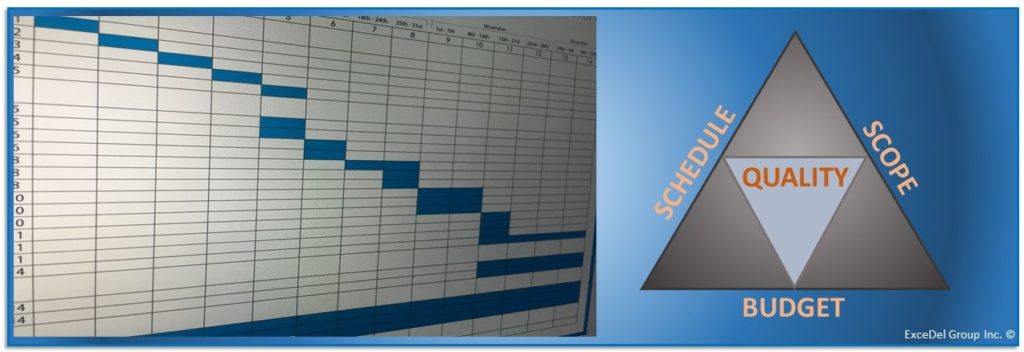
HOW TO MANAGE YOUR PROJECT SCHEDULE
As discussed in Part I of the Triple Constraints; the project schedule, scope, and budget are all closely intertwined and greatly affect the project quality. One of the constraints cannot be changed without impacting the others and therefore, they each need to be managed appropriately. Part I has provided significant detail on how to manage the project schedule; Part II will instruct on how to manage the project scope.
The project scope is best described as the boundaries of the project, as per the PMBOK guide. The scope determines what work will be completed and accomplished throughout the project lifecycle. It should be accurately defined and will allow you, as the Project Manager, to schedule the proper amount of resourcing in the correct amount of time so you can complete the project successfully. Follow these steps to efficiently manage the project scope:
DEFINE THE SCOPE
Prior to the start of the project, the scope will need to be defined. It is always best to sit with the client so you understand their specific needs and what they hope to achieve by the end of the project. The scope should state what the overall objective of the project is and it should be detailed enough to articulate what the project will achieve. Keep in mind, describing what is not in the scope is just as important as defining what is in scope; this will avoid ambiguity, confusion, and wrongful assumptions of deliverables to be met. In addition, understanding the urgency and business needs will help you identify, plan, and manage the scope and determine the project requirements. Once these are determined, you should then identify the minor and major milestones for your timeline and so you can accurately schedule resources and manage both the milestones and timeline effectively. You must also recognize the risks, complexities, and issues that may occur within the project; the project scope will be impacted negatively if your resources are pulled from their main tasks to deal with an issue that could have been mitigated.
RECOGNIZE AND MANAGE SCOPE CREEP
Scope creep happens when the originally agreed to project scope is increased, changed, or decreased while the budget or resources required to achieve the change in scope has not been requested or approved to accept the change. This is often caused by not properly defining the scope, absorbing unapproved change, lack of communication, or not properly documenting the scope and requested changes. These uncontrolled changes can greatly affect the project scope, budget, schedule, and resources; which in turn can cause the project to miss dates, decrease quality, or slip on delivery. To manage scope creep, you need to always be attentive to new requests and decide quickly if you will add them to the project scope or not. You can negotiate new requests with the client and remove items before adding new; ultimately it is the clients’ decision to decide what scope is covered in the project, but as the Project Manager, you are responsible to inform them if an increase in scope will affect the budget, resources, or timeline.
IMPLEMENT A CHANGE CONTROL PROCESS
When a change to the project scope is requested the Project Manager is faced with a magnitude of decisions to make. Areas such as resourcing, budget, schedule, risk, quality, and issues all need to be reassessed to determine the impact of the change. All assessments and decisions need to be documented, communicated, and accepted with sign off prior to implementing a change in scope. The process for project change can vary from client to client. Ensure you are aware of the process that your current client has in place and always follow it appropriately. If the client doesn’t have a firm process in place use your experience and research to find a template that follows the best practices and implement that process into your project, you could even include it in your project plan. See <INSERT LINK FOR 6 STEPS TO EFFECTIVELY MANAGE PROJECT CHANGE> for a more comprehensive guide to managing project change.
MANAGE GOLD PLATING
Gold plating is often considered as a negative when managing a project because the additional enhancements and/or features being added could create risks that have not been accounted for in the project planning phase. Gold plating can impact budget and timelines adversely and may not always please the client. Enhancements and features can be added to the scope of the project at the clients request but should always follow the change control process that is in place so all areas of the project can be considered before approval is granted. If there aren’t enough time, resources, or budget for additional features and enhancements you can always recommend them as a Phase II to the current project or as an entirely separate project if they cannot be incorporated into the current scope.
ORGANIZATION IS KEY
When managing a project, especially a large project, organization will be your most efficient tool for a successful project implementation and managing project scope. Being organized allows you to have visibility into the project scope at all times and from all angles. There are a variety of tools available to help you with organizing the project, preference should be given to any you are familiar and comfortable with. Once organized, you will have better control for handling scope change requests and any change made can immediately be applied to the project plan with changes to resources, budgets, and timelines implemented straightaway.
